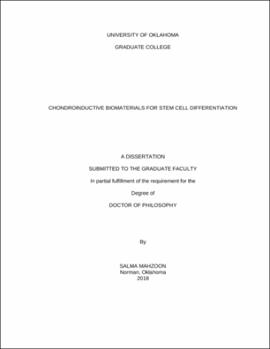| dc.contributor.advisor | Detamore, Michael | |
| dc.contributor.author | Mahzoon, Salma | |
| dc.date.accessioned | 2018-09-04T14:05:39Z | |
| dc.date.available | 2018-09-04T14:05:39Z | |
| dc.date.issued | 2018 | |
| dc.identifier.uri | https://hdl.handle.net/11244/301622 | |
| dc.description.abstract | Cartilage injury, which can lead to arthritis, currently lacks any effective treatment, and so the design of chondroinductive biomaterials holds a compelling appeal for the field of regenerative medicine. Although chondroinductive signaling pathways are conventionally activated by cellular communication with growth factors and extracellular matrix (ECM) components, these natural molecules have translational limitations such as immunogenicity, lack of reproducibility, and high cost. As a result, designing acellular chondroinductive biomaterials with no animal-derived elements presents a clearly superior approach for commercial applications. | en_US |
| dc.description.abstract | Growth factor and ECM molecules often contain cell-binding sequences that could potentially be reproduced in synthetic peptides, and this idea provides the rationale for the current dissertation: evaluation of the chondroinductivity of synthetic peptides to mimic the effects of growth factors and ECM components in cartilage repair. I identified the peptide candidate, SPPEPS, as a matching sequence of two chondroinductive molecules, aggrecan proteoglycan and transforming growth factor-β3 (TGF-β3). The N-terminal subunit of TGF-β3 is known as the latency-associated protein (LAP) and the SPPEPS peptide sequence belongs to the LAP region of TGF-β3 which is known to be a ligand for a number of integrins and integrins play a critical role in cartilage regeneration. First, the properties of SPPEPS and Link N peptides were evaluated in rat bone marrow mesenchymal stem cells (rBMSCs), demonstrating their potential as chondroinductive sequence. Next, I compared the properties of the SPPEPS peptide in isolation and when incorporated with RGD into pentenoate- functionalized hyaluronic acid (PHA) hydrogels, thereby demonstrating the chondroinductive potential of PHA hydrogels. Finally, chondroinductivity was evaluated for SPPEPS or RGD peptides conjugated into PHA hydrogel networks and demonstrated the potential for hydrogels with crosslinked SPPEPS peptides to regenerate tissue with prevalent collagen type II production, which is a faithful reproduction of native hyaline cartilage. Future studies will focus on evaluating the chondroinductivity of PHA hydrogel with different concentrations of SPPEPS peptide, in addition to designing of bifunctional materials with desirable mechanical integrity. | |
| dc.language | en_US | en_US |
| dc.subject | Regenerative Medicine | en_US |
| dc.subject | Tissue Engineering | en_US |
| dc.subject | Biomedical engineering | en_US |
| dc.title | Chondroinductive Biomaterials for Stem Cell Differentiation | en_US |
| dc.contributor.committeeMember | Altan, M. Cengiz | |
| dc.contributor.committeeMember | Siddique, Zahed | |
| dc.contributor.committeeMember | Lee, Chung Hao | |
| dc.contributor.committeeMember | Zheng, Bin | |
| dc.date.manuscript | 2018-08-31 | |
| dc.thesis.degree | Ph.D. | en_US |
| ou.group | College of Engineering::School of Aerospace and Mechanical Engineering | en_US |
